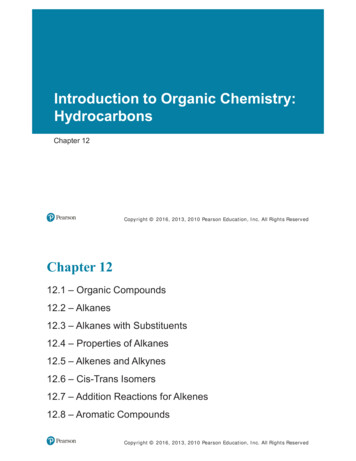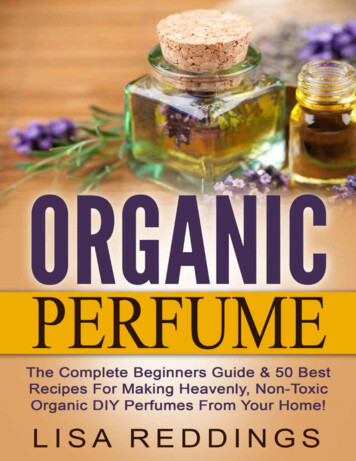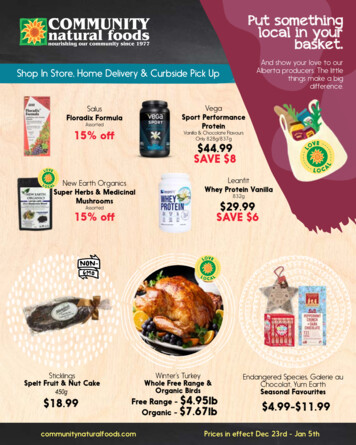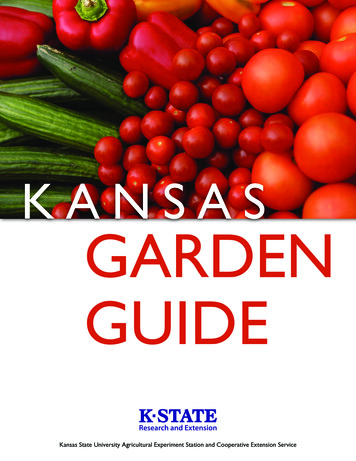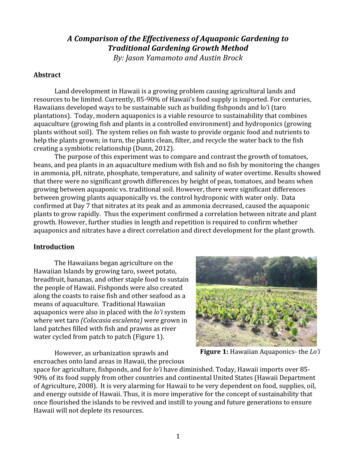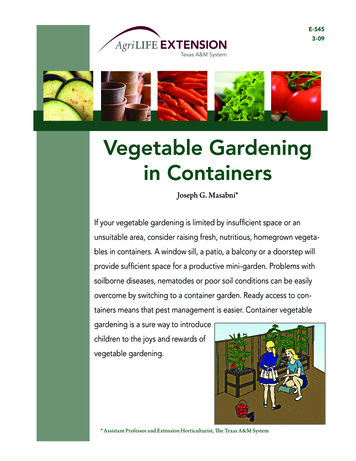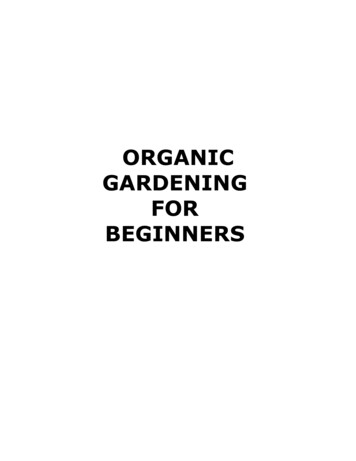
Transcription
ORGANICGARDENINGFORBEGINNERS
TABLE OF CONTENTSIntroductionWhy Garden Organically?The Risk of ChemicalsWhat Is Organic Gardening?Planning Your GardenGetting the Soil ReadyPlanting Your GardenStarting Seeds IndoorsControlling Those WeedsControlling PestsCommon Garden PestsMaking Your Own CompostTending the GardenWintering Your GardenRecipes for your Organic GardenOrganic FertilizerGarlic Pest Control SprayDormant OilHomemade Insecticidal SoapAll Purpose Pest Control SprayBug 494950
INTRODUCTIONFor some people, gardening is a passion. Some peoplegarden just as a hobby. For still others, it’s a way to feedtheir families. We think Shirley MacClaine’s character in“Steel Magnolias” said it best. “Because that’s whatSouthern women do – we wear funny hats and grow thingsin the dirt.”You don’t have to be from the South or be a woman, oreven wear a funny hat to enjoy gardening. The thrill ofseeing your first red, ripe tomato or watching your first stalkof corn reach from the ground can be an amazingexperience for many people.Gardening is also a great way to provide healthy foodfor you and your loved ones. When you buy produce fromthe store, it just isn’t the same as presenting a salad to yourfamily that came exclusively from your garden worked byyour own two hands.Many people choose to garden so they can have controlover what type of food they eat without fear of chemicals orpreservatives. Often, commercially grown produce iscultivated in greenhouses with the use of pesticides andchemicals to enhance their growth.
A quick study on these types of artificial applicationscan be unnerving for anyone. The side effects of chemicalpesticides on the human body can truly take its toll. Somany people are jumping on the “organic bandwagon” as away to minimize the risks to themselves and their lovedones that often comes with commercially prepared foods.You don’t have to be a health nut to embrace organicgardening. Imagine the wonderful way you’ll feel knowingthat you are serving foods that were grown all naturallywithout the risks that come from applying chemicalfertilizers and pesticides.It’s easier than you think. If you’ve been gardening foryears or are just beginning to grow your own food, organicgardening can provide you with peace of mind and pride inyour produce. Don’t have any clues how to start? That’swhy you’re reading this book!We will explore the advantages of organic gardening aswell as the best way to begin your all-natural garden. We’llgive you ideas about mulching, weed control, andcomposting. Plus, we’ll give you some ideas on all-naturalpest controls and ways to make sure your garden thrives –without chemicals!Let’s begin our journey into “Organic Gardening forBeginners”!WHY GARDEN ORGANICALLY?As recent as 25 years ago, the idea of organicgardening was considered quite a radical concept. How inthe world were gardeners expected to control the weeds,the bugs, and the animals that could threaten a thrivinggarden without the use of man-made chemicals?
When you think about it, organic gardening is a reallysimply theory. For years, people have been growing thingswithout the use of chemicals. The early settlers of ourcountry didn’t have Miracle-Gro or Sevin Dust and theymade out just fine.It only makes sense that we should be able to applythe same techniques and get the same results as they didtoday. We should grow food using Mother Nature'singredients rather than concoctions born in a chemist'slaboratory for the good of all of us.But the interest in organic gardening goes beyond justthe benefits for us and our families. There has been a risein the interest of ecology and concern about theenvironment that has given new life to the renewed interestin this form of gardening. By using natural minerals andmaterials, by taking advantage of natural predators, and byrecycling garden waste, the home gardener can maintain anorganic garden quite successfully.There are many, many advantages to gardeningorganically. Probably first and foremost is that Foodproduced using organic agriculture is more nourishing andmore healthful.In early August, 2001, the British organization, The SoilAssociation, reported that a comprehensive review ofexisting research revealed significant differences betweenorganically and non-organically grown food. Thesedifferences relate to food safety, primary nutrients,secondary nutrients and the health outcomes of the peoplewho eat organicallyVitamin C and dry matter contents are higher, onaverage, in organically grown crops then they are innon-organic crops. Mineral contents are also higher, onaverage, in organically grown crops. Food grown organically
contains "substantially higher concentrations of antioxidantsand other health promoting compounds than crops producedwith pesticidesMany people think that organically grown foods tastebetter. Also, some foods grown without pesticides producea higher amount of an anti-oxidant that has been found toreduce the risk of some cancers.Overall, though, most people who enjoy organicgardening report that the enjoyment they derive isparamount to their decision to eschew chemicals in favor ofthe all-natural route. Many people like to watch the tendernew growth come to full maturity and, as a bonus, you getto eat it!With organic gardening, you get extra freshvegetables. Naturally, corn on the cob and newly pickedpeas are especially noticeable, but this trait extends to allvegetables you grow yourself, especially under the organicmethod. A phenomenon noted by most people whenharvesting their very first vegetables from their very firstgarden is that everyone eats much more of a givenvegetable than they would of a similar store bought variety.You will save money not only by growing your ownfood, but you can even make a little extra cash on the sideby selling your own all-natural foods that are so popular inthe grocery stores these days. If you have canned all thetomatoes you can and still have bushels left over, you cantake the extra to the farmer’s market and sell your organictomatoes to others who don’t have the advantage of theirown garden.For any gardener who still hasn't been convinced aboutthe need to garden organically, here are some statistics thatmay help change your mind. In March of 2001, theAmerican Cancer Society published a report linking the useof the herbicide glyphosate (commonly sold as Round-up)
with a 27% increased likelihood of contractingNon-Hodgkins Lymphoma.John Hopkins University also revealed that homegardeners use almost 10 times more pesticide per acre thanthe average farmer and that diseases caused byenvironmental illness, exposure to chemicals etc., is nowthe number one cause of death in the U.S. With the EPA'srecent phasing out of common pesticides such as Dursbanand Diazinon, we are now realizing that many of thechemicals that we thought were "safe" were never actuallytested to see what their affect on children, women, and theelderly could be. The time has come to reassess ourdependence on pesticides.However, you may be asking why are chemicals so badif we’ve been using them for years and years?THE RISK OF CHEMICALSWe have chemicals in our everyday lives everywhere.Shampoo, toothpaste, many foods, even our clothing allcontain or are manufactured with the use of chemicals.Besides polluting the environment, the use of chemicals canbe much more threatening. But we’re concentrating ongardening and the use of these chemicals on our food. Oneof the prominent ways chemicals are used in foodproduction is through chemical fertilizers.Chemical fertilizers are quick-acting, short-term plantboosters and are responsible for:1. Deterioration of soil friability creating hardpans soil2. Destruction of beneficial soil life, including earthworms3. Altering vitamin and protein content of certain crops
4. Making certain crops more vulnerable to diseases5. Preventing plants from absorbing some neededminerals.The soil must be regarded as a living organism. An acidfertilizer, because of its acids, dissolves the cementingmaterial, made up of the dead bodies of soil organisms,which holds the rock particles together in the form of soilcrumbs. This compact surface layer of rock particlesencourages rain water to run off rather than enter the soil.For example, a highly soluble fertilizer, such as 5-10-5,goes into solution in the soil water rapidly so that much of itmay be leached away into our ground water withoutbenefiting the plants at all. This chemical causes the soil toassume a cement-like hardness. When present in largeconcentrations, they seep into the subsoil where theyinteract with the clay to form impervious layers ofprecipitates called hardpan.Many artificial chemical fertilizers contain acids, assulfuric and hydrochloric, which will increase the acidity ofthe soil. Changes in the soil acidity (pH) are accompanied bythe changes in the kinds of organisms which can live in thesoil. For this reason, the artificial fertilizer people tell theircustomers to increase the organic matter content of theirsoil or use lime to offset the effects of these acids.There are several ways by which artificial fertilizersreduce aeration of soils. Earthworms, whose numerousborings made the soil more porous, are killed.The acid fertilizers will also destroy the cementingmaterial which bins rock particles together in crumbs.Chemical fertilizers rob plants of some natural immunity bykilling off the micro organisms in the soil.Many plant diseases have already been considerablychecked when antibiotic producing bacteria or fungi thrived
around the roots. When plants are supplied with muchnitrogen and only a medium amount of phosphate, plantswill most easily contract mosaic infections. Host resistanceis obtained if there is a small amount of nitrogen and a largesupply of phosphate. Fungus and bacterial diseases havebeen related to high nitrogen fertilization, and lack of traceelements.Plants grown with artificial chemical fertilizers tend tohave less nutrient value than organically grown plants. Forexample, several tests have found that by supplying citrusfruits with a large amount of soluble nitrogen will lower thevitamin C content of oranges. It has also been found, thatthese fertilizers that provide soluble nitrogen will lower thecapacity of corn to produce high protein content.Probably the most regularly observed deficiency inplants treated continually with chemical fertilizers isdeficiencies in trace minerals. To explain this principle willmean delving into a little physics and chemistry, but you willthen easily see the unbalanced nutrition created in chemicalfertilized plants.The colloidal humus particles are the convoys thattransfer most of the minerals from the soil solution to theroot hairs. Each humus particle is negatively charged andwill, attract the positive elements, such as potassium,sodium, calcium, magnesium, manganese, aluminum,boron, iron, copper and other metals. When sodium nitrateis dumped into the soil year after year, in large doses, aradical change takes place on the humus articles.The very numerous sodium ions (atomic particles) willeventually crowd out the other ions, making them practicallyunavailable for plant use. The humus becomes coated withsodium, glutting the root hairs with the excess. Finally, theplant is unable to pick up the minerals that it really needs.
So, with chemical fertilizers, in short, you haveshort-time results, and long-term damage to the soil,ground water and to our health.Another reason to avoid the use of chemicals andpesticides is that long term use of such chemicals candeplete the soil and leave it unable to sustain furthergrowth. In many cases beds of perennials suddenly stopblooming for no apparent reason, and the culprit is oftenfound to be the overuse of chemical fertilizers, herbicidesand pesticides.Chemicals that are applied to plants can often seep intothe water supply thus contaminating it. While it’s true, ourdrinking water does go through a filtration process, it’s beenproven that this process doesn’t remove ALL of the harmfulcontaminants.It has also been proven that certain chemicals cancause diseases, birth defects, and other hazardous healthproblems. All one needs to do is watch the movie “ErinBrokovich” to see what chemical contamination of water cando to a body.Consumers worry about filthy slaughterhouses, e-coli,salmonella and fecal contamination. The CDC estimates that76 million American suffer food poisoning every year. Thereare no documented cases of organic meat, poultry or dairyproducts setting off a food poisoning outbreak in the UnitedStates.Consumers are also concerned about toxic sewageused as fertilizer on conventional farms. Organic farmingprohibits the use of sewage sludge.They worry about untested and unlabelled geneticallyengineered food ingredients in common supermarket items.Genetically engineered ingredients are now found in 60
percent to 75 percent of all U.S. foods. Although pollsindicate 90 percent of Americans want labels ongene-altered foods, government and industry refuse tolabel. Organic production forbids genetic engineering.Eating organic eliminates, or minimizes, the risk frompoisoning from heavy metals found in sewage sludge, theunknowns of genetically modified food, the ingestion ofhormone residues, and the exposure to mutant bacteriastrains. It also reduces the exposure to insecticide andfungicide residues.Residues from potentially carcinogenic pesticides areleft behind on some of our favorite fruits and vegetables - in1998, the FDA found pesticide residues in over 35 percent ofthe food tested. Many U.S. products have tested as beingmore toxic than those from other countries. What's worse isthat current standards for pesticides in food do not yetinclude specific protection for fetuses, infants, or youngchildren despite major changes to federal pesticide laws in1996 requiring such reforms.It is certainly in the best interests of the humanpopulation to avoid chemicals in our food, but it’s also betterfor our planet as well. Chemicals can affect the soil makingit less fertile. They destroy important parts of the naturaleco-system. All plants and animals serve some sort ofpurpose – even if that purpose isn’t especially obvious. Bytaking these components out of the natural life cycle, we areendangering our environment in ways we can’t necessarilysee outright, but that danger is there.So it becomes obvious that growing your food naturallyis the best way to go. Let’s take a moment and look at whatexactly organic gardening is.
WHAT IS ORGANIC GARDENING?Many gardeners wonder what exactly organicgardening means. The simple answer is that organicgardeners don't use synthetic fertilizers or pesticides ontheir plants. But gardening organically is much more thanwhat you don't do.When you garden organically, you think of your plantsas part of a whole system within nature that starts in thesoil and includes the water supply, people, wildlife and eveninsects. An organic gardener strives to work in harmonywith natural systems and to minimize and continuallyreplenish any resources the garden consumes.Organic gardening operates on the concept ofrecycling. You use animal waste, kitchen scraps, andvegetable waste to mulch and compost. You will usecommon household items like vinegar and soap to preventpests and weeds.Organic growers rely on developing a healthy, fertilesoil and growing a mixture of crops. Genetically modified(GM) crops and ingredients are not allowed under organicstandards.Organic gardening is the merging together of plantsand soil allowing the Earth to naturally bear what it wasmade to do. The plants and the soil are one workingtogether to provide food and nourishment not only tohumans but to animals and organisms as well.It’s not a new age science. It’s actually quite simpleand can be satisfying to the soul! So let’s get more in-depthon getting started.
PLANNING YOUR GARDENYour first task is choosing where to plant your garden.The site should receive at least six hours of direct sunlightdaily, and the soil should drain well, with no standingpuddles. The area should receive adequate air circulation,yet be protected from strong winds. Your house or a thicketof trees can act as a shield from the wind.After choosing your site, decide how large you want tomake your garden. Beware of beginning too ambitiously;tending a plot that's too large can quickly become a chore. Aplot 10 feet long by 10 feet wide is large enough for sometomato plants, lettuce, a bush variety of cucumber plant,radishes, an endlessly productive zucchini plant, herbs andsome flowers.Once you've chosen your site, draw out a garden plan;this plan will ensure maximum productivity by giving eachplant room to grow. Measure the dimensions of the plot anddraw a scale model on graph paper, using, for example, aone-inch square to represent one foot.As you draw your plan, keep in mind each plant's spacerequirements at maturity--the little tomato plants you putout in the spring will take up three feet of space by the endof summer. Consider laying out your garden design in blocksinstead of the more familiar rows. Because you don't haveto allow as much space for paths, this will enable you toplant more.Blocks containing a variety of plants encouragemini-gardens of vegetables, herbs and flowers, and aremore diverse than single rows that alternate just two plants.Single crops crowded together are more susceptible todisease, so the diversity of blocks can mean healthierplants. Make each block just wide enough so you cancomfortably reach the middle from each side.
The layout of your garden depends in part on what it isyou want to plant. Some crops, such as lettuce, radishesand spinach, mature quickly and will be short-termresidents, unless you plant and harvest them several timesduring the summer. Other plants, such as tomatoes,eggplant and peppers, will grow over the course of theentire season. Perennial herbs and flowers will remain in thesame spot year after year, requiring an increasing amountof space each year.Be sure to save your garden plan to use as a referencefor rotating crops next year. Besides depleting the soil ofnutrients, leaving plants in the same spot each yearencourages disease and soil-borne insect predators. Noannual plant should go in the same spot two years in a row.If you wait three years before putting a plant in the samespot, that works even better.It is a good idea to consider planting “green manure”plants to fix the soil. You can add this to your plan fromyear to year. Clover, Alfalfa, and other such plants fixnutrients from the soil, which can be used by other plants,as well as adding bulk and organic matter to the soil, whenthey are dug, or tilled directly into the soil.Another key to growing organically is to choose plantssuited to the site. Plants adapted to your climate andconditions are better able to grow without a lot of attentionor input; on the other hand, when you try to grow a plantthat is not right for your site, you will probably have toboost its natural defenses to keep it healthy and productive.Once you plan out your garden for this year, youshould really make a plan for next year as well. Becausecrop rotation is so important to keep healthy soil, as long asyou’re making a plan, draw up where you will plant what in
the next season. This will help you remember what wasplanted where and save troubles next year.So now you know where you’ll put your garden andwhat you’re going to put in it. Let’s get started on theplanting!GETTING THE SOIL READYProper soil preparation is the key to successful organicgardening. The goal is to feed the soil, which in turn willfeed your plants. Begin by testing your soil to find outprecisely what you've got to work with. Contact your localCooperative Extension Service. Most counties and someuniversities have one; look in the phone book under"Cooperative," "Extension" or your county name to find outwhat is required for a soil test. Home test kits are availableat garden-supply stores, but their results are not asaccurate or complete.A soil test will measure pH, the soil's acidity oralkalinity. The recommended pH for a vegetable garden is6.8. The test results should include guidelines for adjustingthe pH, for example, how much lime to add to acid soils orhow much sulfur to add to alkaline soils. Both are availableat gardening centers.The test also should analyze the amounts of nitrogen,phosphorous, potassium, calcium and other elements in thesoil that are critical for healthy plants. The testing agencymay suggest nutriments to balance these elements; whenyou mail off your sample, be sure to enclose a note statingthat you intend to garden organically so the tester does notsuggest chemicals.Some of the nitrogen sources the tester may suggestcan be problematic, especially for vegetarians: Bone meal is
a slaughterhouse byproduct, fish emulsion is afish-processing byproduct, cottonseed meal is subject toheavy pesticide use and urea, or crystallized animal urine, isso processed it can no longer be considered even remotelynatural. If nitrogen is a problem for your soil, and you areopposed to using animal byproducts, your best bet may beto plant a nitrogen-fixing cover crop this first year and startyour vegetables the next.When gardeners speak of a soil, they are referring toearth that looks, feels and smells pleasant. That meansfertile soil, with good structure depending on the extent towhich the inorganic soil particles; sand, silt, clay, andhumus are bound together. No matter what kind ofmiserable soil you begin with, it can be transformed into thestuff great gardens are made of.You also should test the soil's percentage of organicmatter, or decomposed plant material. There are differentlevels of consideration according to your area that willdetermine if a soil is organic. The best organic matter tofertilize your garden with is compost. As a new gardener,you may not have compost of your own yet, but we’ll helpyou out with that a little later in the book.Composting involves recycling of natural matter likevegetable peels, coffee grounds, and egg shells. All of thesewill provide nutrients to the soil that a successful organicgardener knows are of paramount importance!When you till up your plot, work in some loose topsoilalong with natural organic matter into the existing soil.Horse or cow manure will work the best here. Find a localfarmer and ask if you can buy some dung from him. If youdon’t have any of these available to you, most local gardencenters will have some natural additives that you can tillinto the soil. You can also use leaves or grass clippings.By tilling this organic matter into the soil, the organicmaterial will form moisture-holding humus in the soil and
the loose structure will permit good drainage. Plus, it canprovide needed nutrients to your plants and help themthrive as they grow.You can make your own organic fertilizer as well. We’llgive you a couple of great “recipes” in later sections.Be careful that you don’t dig up your plot too soon inthe season. Cool spring soil holds moisture, and disturbingwet soil will damage its structure. We found one tip onlinethat can help you determine whether or not your soil isready for tilling.Jim Crockett, former Public Broadcasting Systemgardener extraordinaire, suggests that before digging youtake "the chocolate cake test": If the soil has theconsistency of moist chocolate cake, it's safe to dig. If it'smore like fudge, wait until the soil has dried out to cakeconsistency.Soil is structured in layers, and it's best not to disturbthose layers. Dig down just far enough to remove clods ofgrass, weeds and root masses, shaking and pounding out asmuch dirt as possible back into your garden. Save the grassfor composting.After the dirt is prepared, let the garden rest for acouple of days before planting.It’s almost time to plant!PLANTING YOUR GARDENYou can choose to buy plants that are already growingthat can be found at most garden centers, but if you do this,you can’t be sure what pesticides have come in contact withthese plants. Your goal, as an organic gardener, is to avoid
these chemicals, so we recommend starting your gardenfrom seed.If you want to simply plant the seeds directly in theground, that’s fine, just remember that growing from seedtakes a little more time than growing from plants, so bepatient!Don’t get too over-anxious here! Many beginners willtake a seed packet and dump its contents into the groundhoping a few plants will spring up. What they don’t realizeis that with care, they will probably ALL come up – or atleast most of them.The problem here is that these plants will strive for airand light developing tall, weak stems and they will notthrive as they choke each other out.There are some plants that can be seeded thickly.These include peas, parsnips, radishes and bush beans. It’sfine to block these together as they will grow fine in clumps.Seeds have within them everything they need to grow,except moisture and warmth. But, if you pile 4-inches of soilover them, though, they are overwhelmed. The soil is heavyand cold and often damp enough to rot off the emerging leafbud before it can break the surface. Be kind to your seeds.Cover them with soil to a depth no more than 2-times theirsize. Very fine seeds shouldn’t be covered at all.There are also some vegetables that are conducive toearly planting. These include radishes and leaf lettuce.They tend to come up quickly and can be harvested beforeany of your other plants have even begun to bud.With these types of plants, plant a single row or smallbed and keep replanting every two or three weeks in small
amounts. You’ll take up the same amount of space, saveharvest time, and have a continuous crop throughout thegrowing season.When planting your seeds, you’ll need to dig a smalltrench and sprinkle them evenly throughout the row. Therows should be at least an inch apart, but increasing thatdistance make for easier weeding and gives you walkingspace between the rows.As we said, sprinkle them evenly and try to avoidcrowding. In other words, don’t just dump the seed packetin the trench. You must leave room for the plants to growand be able to get adequate light and air circulation.Once they’re in the ground, mark what you haveplanted where. We use a Popsicle stick with the plant namewritten on the front and stick it in the ground at thebeginning of the row. This way once the plants start to bud,you’ll know where to look for them.Water well after you’ve planted your seeds and thenwait. You’ll soon begin to notice small plants poppingthrough the soil and reaching for the sun. Before long, withproper cultivation, you’ll have beautiful plants!Sometimes, it’s more satisfying to start your seedsindoors in the winter time so that when the spring arrives,you’ll have your own organically grown starter plants readyto put into your garden plot. Let’s look at how to start yourseeds indoors.STARTING SEEDS INDOORSStarting your seeds indoors will lessen the amount oftime you have to wait to see results in your garden, and
many people prefer to grow their plants indoors first toready them for the growing season. It can be motivationaland satisfying.If space is available near a sunny window, start seedsfour to eight weeks before the plant-out date in your area(average date of last killing frost). Starting too early usuallyresults in spindly plants due to crowding and lack ofsufficient light.Almost any container with drainage holes in the bottomwill work for planting. Paper milk cartons cut in half,Styrofoam cups, tin cans, plastic trays and pots are commoncontainers used. For convenience, however, you may wishto start plants in the plastic trays and pots available atgarden supply centers.Use a rich, well-drained soil. Potting soils made forAfrican violets and other house plants usually are suitableand do not have weed seeds. They are, however, moreexpensive than soil mixes you can make at home. If you usesoil from the yard, it should be top soil that is well drainedand not high in clay.The best soils are often found around establishedshrubs and trees. Add sphagnum peat and sharp sand to thesoil in a ratio of about one-half volume of each, and mixedthoroughly.To kill weed seeds and some damaging soil fungipresent in your commercial soil, place the soil mix in shallowtrays or baking pans in an oven for 45 minutes at 250degrees. For best results, the soil should be moist.After the soil has cooled, fill containers firmly but do notpack. Allow about 3/4 inch from the soil surface to the rim ofthe container. Place seeds on the soil surface. Use apiece of window screen or old flour sifter to sift soil over theseeds to the depth indicated on the seed packet.
If you use compartmentalized trays or individual peatpots, place two or three seeds in each pot. Do not cover toodeeply, as this may reduce or prevent seed germination.Just like planting directly in the ground, a general rule is tocover no more than four times the diameter of the seed.Apply a fine spray of water to avoid washing the seed,causing them to float to the soil surface. Household windowsprayers are suitable.Cover the containers with plastic sheets or panes ofglass and place in a cool room (60 to 65 degrees) away fromdirect sunlight until germination. By doing this, you willalmost eliminate the necessity of watering the bed againbefore the seeds germinate. Be sure to keep an eye on itthough. DON'T let it completely dry out!Germination can take anywhere from a few days to acouple of months, depending on what you are growing, sopatience will have to be on of your virtues.When seeds germinate, move them gradually (over twoor three days) into brighter light. When the seedlings havedeveloped the first true leaves (the leaves above thecotyledons or “seed leaves”), thin to one plant per containerif using partiti
composting. Plus, we'll give you some ideas on all-natural pest controls and ways to make sure your garden thrives - without chemicals! Let's begin our journey into "Organic Gardening for Beginners"! WHY GARDEN ORGANICALLY? As recent as 25 years ago, the idea of organic gardening was considered quite a radical concept. How in

